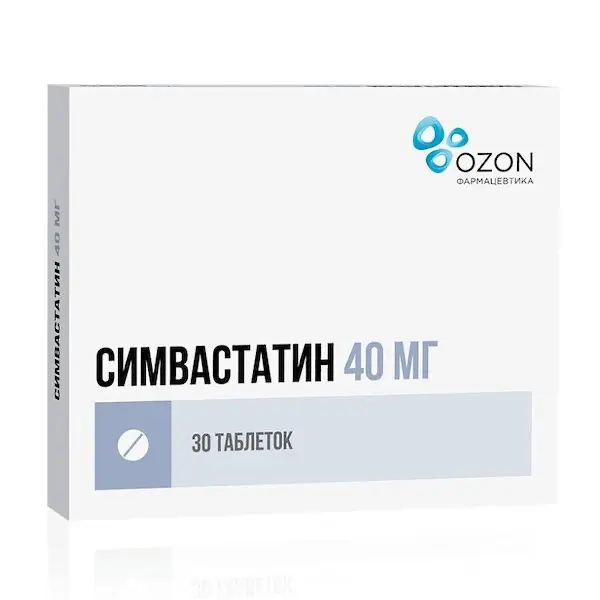Description
Simvastatin Pharmacological action
Hypolipidemic agent obtained synthetically from the fermentation product of Aspergillus terreus, is an inactive lactone, which undergoes hydrolysis in the body to form a hydroxy acid derivative. The active metabolite inhibits 3-hydroxy-3-methylglutaryl-CoA reductase (HMG-CoA reductase), the enzyme that catalyzes the initial reaction of mevalonate formation from HMG-CoA. Since the conversion of HMG-CoA to mevalonate represents an early step in cholesterol synthesis, the use of simvastatin does not cause accumulation of potentially toxic sterols in the body. HMG-CoA is easily metabolized to acetyl-CoA, which is involved in many synthesis processes in the body.
Causes lowering of plasma levels of triglycerides (TG), low-density lipoproteins (LDL), very low-density lipoproteins (VLDL) and total cholesterol (in cases of heterozygous familial and non-familial hypercholesterolemia, in mixed hyperlipidemia, when elevated cholesterol is a risk factor). Increases high density lipoproteins (HDL) and reduces the ratio of LDL/HDL and total cholesterol/HDL.
Onset of the effect – 2 weeks after the start of treatment, the maximum therapeutic effect is achieved in 4-6 weeks. The effect is maintained during continuation of treatment, cholesterol content gradually returns to the initial level after discontinuation of therapy.
Indications
Patients with coronary heart disease or high risk of CHD
In patients at high risk of CHD (with or without hyperlipidemia), such as patients with diabetes mellitus, patients with a history of stroke or other cerebrovascular disease, patients with peripheral vascular disease or patients with CHD or predisposition to CHD, Simvastatin is indicated for:
– Reduce the risk of overall mortality by reducing mortality due to CHD.
– Reducing the risk of serious vascular and coronary complications:
– nonfatal myocardial infarction,
– coronary death,
– stroke,
– Revascularization procedures.
– Reducing the risk of the need for surgical interventions to restore coronary blood flow (such as aortocoronary bypass and percutaneous transluminal coronary angioplasty).
– Reducing the risk of the need for peripheral blood flow restoration surgery and other types of noncoronary revascularization.
– Reducing the risk of hospitalization for angina attacks.
Hyperlipidemia .
– As an adjunct to diet, when the use of diet alone and other non-drug therapies in patients with primary hypercholesterolemia, including heterozygous familial hypercholesterolemia (Fredrickson type IIa hyperlipidemia), or mixed hypercholesterolemia (Fredrickson type IIb hyperlipidemia), is not sufficient to:
– reduce elevated concentrations of COX, LDL cholesterol, TG, apo B;
– increase in concentration of HDL cholesterol;
– decrease in LDL cholesterol/LDL cholesterol and HDL cholesterol/HDL cholesterol ratios.
– Hypertriglyceridemia (type IV hyperlipidemia according to Fredrickson classification).
– Supplementation with diet and other treatments for patients with homozygous familial hypercholesterolemia to reduce elevated concentrations of CHC, LDL cholesterol and apo B.
– Primary dysbetalipoproteinemia (Fredrickson type III hyperlipidemia).
Use in children and adolescents with heterozygous familial hypercholesterolemia
Simvastatin is indicated concomitantly with diet to decrease elevated concentrations of CHC, LDL cholesterol, TG, apo B in adolescents 10-17 years old and in girls 10-17 years old at least 1 year after menarche (first menstrual bleeding) with heterozygous familial hypercholesterolemia.
Contraindications
– Hypersensitivity to any component of the drug.
– Liver disease in the active phase or persistent increase in the activity of “hepatic” transaminases in the blood plasma of unknown etiology.
– Pregnancy or breast-feeding.
– Age under 18 years old (except children and adolescents 10-17 years old with heterozygous familial hypercholesterolemia) (see Indications for use).
– Lactose intolerance, lactase deficiency or glucose-galactose malabsorption.
– Concomitant use with potent CYP3A4 isoenzyme inhibitors (itraconazole, ketoconazole, posaconazole, voriconazole, HIV protease inhibitors, boceprevir, telaprevir, erythromycin, clarithromycin, telithromycin, nefazodone and drugs containing cobiciztate) (see “Interaction with other drugs”). Interaction with other medicinal products; Cautions, Myopathy/Rhabdomyolysis).
– Concomitant use with gemfibrozil, cyclosporine or danazole (see Interaction with other medicinal products; Cautions, Myopathy/Rhabdomyolysis).
– Concomitant use of simvastatin at a dose greater than 40 mg with lomitapide in patients with homozygous familial hypercholesterolemia (see Interaction with other medicinal products, Other drug interactions; Precautions, Myopathy/Rhabdomyolysis).
Caution
Severe renal dysfunction (CKR less than 30 ml/min); alcohol abuse prior to treatment; history of liver disease; hereditary muscle disease, myopathy in the background of statins, reduced or increased skeletal muscle tone of unclear etiology; uncontrolled hypothyroidism; planned surgical interventions, severe therapeutic and surgical diseases; concomitant use with fibrates (except fenofibrate), nicotinic acid in lipid-lowering doses (more than 1 g/day), amiodarone, amlodipine, verapamil, diltiazem, ranolazine, dronedarone, grapefruit juice; diabetes; use in patients of Mongoloid race, old age (over 65 years, especially women).
Use in pregnancy and during breastfeeding
Pregnancy
Simvastatin drug is contraindicated in pregnant women. Since the safety for pregnant women is not proven and there are no data that treatment with the drug during pregnancy brings obvious benefits, the drug should be immediately discontinued at the onset of pregnancy. Simvastatin should be administered to women of childbearing age only in cases where the likelihood of pregnancy is very low. Simvastatin use during pregnancy may decrease the concentration of mevalonate (a precursor in cholesterol biosynthesis) in the fetus. Atherosclerosis is a chronic disease and usually discontinuation of hypolipidemic drugs during pregnancy has little effect on the long-term risks associated with primary hypercholesterolemia. Therefore, Simvastatin should not be used in women who are pregnant, are trying to become pregnant, or are suspected of being pregnant. Treatment with Simvastatin should be withheld for the duration of pregnancy or until pregnancy is diagnosed and the woman has been warned of the possible danger to the fetus (see Contraindications).
Breastfeeding.
There are no data on excretion of simvastatin and its metabolites with breast milk. If it is necessary to prescribe the drug Simvastatin to a woman during lactation, it should be taken into account that many drugs are excreted with the breast milk, and there is a risk of serious adverse reactions. Therefore, the drug should be discontinued while breastfeeding.
Fertility
There are no data on the effect of simvastatin on fertility in women. Simvastatin has no effect on fertility in male and female rats.
Dosage regimen and administration
- To ensure the dosage regimen indicated below, if it is necessary to use Simvastatin in doses of 5 mg and 10 mg, preparations of other manufacturers should be prescribed, in the dosage form “tablets 5 mg” or “tablets 10 mg” with a rib.
- Prior to treatment with Simvastatin, the patient should be prescribed a standard hypocholesterolemic diet, which should be followed during the entire course of treatment.
- Recommended doses of Simvastatin are from 5 to 80 mg per day. The drug should be taken once a day in the evening. If necessary, the drug dose is increased at intervals of at least 4 weeks to a maximum of 80 mg once a day in the evening. The dose of 80 mg daily is recommended only for patients with high risk of cardiovascular complications if treatment with the drug in lower doses failed to achieve the target lipid levels and the estimated benefit of therapy exceeds the possible risk (see Cautionary Note, Myopathy/Rhabdomyolysis).
- Patients with coronary heart disease or high risk of CHD
Standard initial dose of Simvastatin for patients with high risk of CHD in combination with or without hyperlipidemia (in the presence of diabetes mellitus, history of stroke or other cerebrovascular disease, peripheral vascular disease) and for patients with CHD is 40 mg once daily in the evening. Drug therapy should be prescribed simultaneously with diet and exercise therapy. - Patients with hyperlipidemia without the above risk factors
The standard starting dose of Simvastatin is 20 mg once daily in the evening. For patients who need a significant (more than 45%) decrease in LDL cholesterol concentration, the initial dose may be 40 mg once daily in the evening. In patients with mild or moderate hypercholesterolemia, Simvastatin therapy can be administered in a starting dose of 10 mg once daily. If necessary, the doses should be adjusted according to the above scheme (see Dosage and administration). - Patients with homozygous familial hypercholesterolemia
Simvastatin is recommended in a dose of 40 mg daily taken once in the evening. A dose of 80 mg is recommended only if the anticipated benefit of therapy is greater than the possible risk (see Cautionary Note, Myopathy/Rhabdomyolysis). In such patients, Simvastatin is used in combination with other methods of hypolipidemic treatment (e.g., LDL-apheresis) or without such treatment, if it is not available. - For patients taking lomitapide concomitantly with Simvastatin, the daily dose of Simvastatin should not exceed 40 mg (see Interaction with other medicinal products; Precautions, Myopathy/Rhabdomyolysis).
- Concomitant therapy
Simvastatin may be administered both in monotherapy and in combination with bile acid sequestrants.
In patients taking Simvastatin concomitantly with fibrates other than gemfibrozil (see Contraindications) or fenofibrate, the maximum recommended dose of Simvastatin is 10 mg per day.
For patients taking amiodarone, verapamil, diltiazem, drugs containing elbasvir or grazoprevir or amlodipine simultaneously with Simvastatin, the daily dose of Simvastatin should not exceed 20 mg (See Interaction with other medicinal products; Precautions, Myopathy/Rhabdomyolysis). - If renal function is impaired.
Since Simvastatin is excreted by the kidneys in small amounts, there is no need to change the dose in patients with moderate renal impairment. In patients with severe renal impairment (CKD < 30 ml/min) the appropriateness of prescribing the drug in doses greater than 10 mg per day should be carefully weighed. If such doses are considered necessary, they should be prescribed with caution (see Caution). - Administration in children and adolescents 10-17 years of age with heterozygous familial hypercholesterolemia
- The recommended starting dose is 10 mg daily in the evening. The recommended dosing regimen is 10-40 mg per day, the maximum recommended dose of the drug is 40 mg per day. Dosage selection is performed individually according to the therapy goals.





